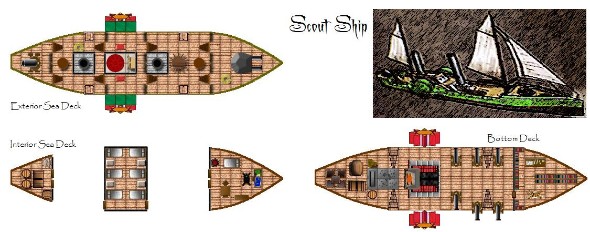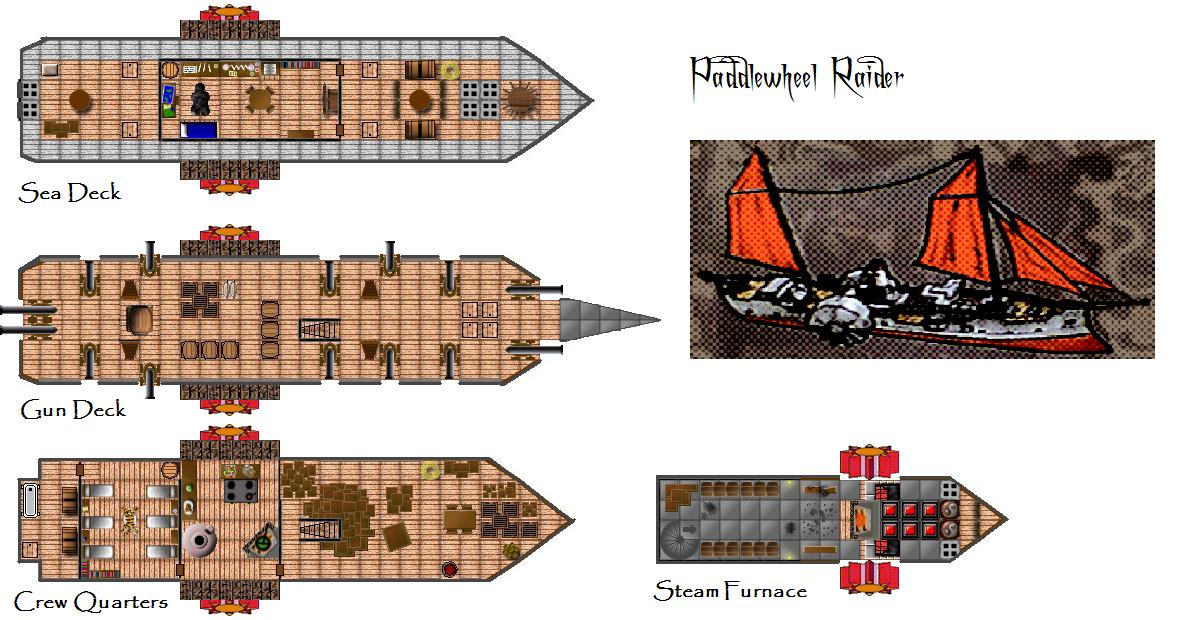Grimgrin
First Post

The steamboat gunship is a wooden hull vessel powered by wind and steam driven paddlewheels. It is slower than the similarly sized two mast brig, but can move against the wind or without wind. The steamboat still uses a small three sails hanging from its two mast in order to improve fuel economy and not overtax the steam engine. This vessel is common on most rivers and lakes and is used to ferry people and small loads of cargo. It is also favored by river pilots for is shallow draft, maneuverability, and unremarkable appearance. A steamboat gunship can not mount more than a pair of cannons; one at the bow and one at the stern.
Steamboat (Gargantuan Vehicle)
Space: 4sq. By 10sq.
HP: 250
AC: 2
Fortitude: 15
Reflex: 2
Speed: Swim 6 (By sails alone: swim 3)
Cost: 2400gp
Pilot
The pilot must stand at the ship‘s wheel, which is typically in the pilot house in the center of the top deck.
Crew
In addition to the pilot, a steamboat has a crew of four that maintain the engine, keep it stoked with coal or firewood, and trim the sails. Reduce the ships speed by 25% for each missing crew member. Zero speed means the ship is out of control. It takes 30 rounds to heat the steam boiler to operating pressure.
Load
The ship can haul a maximum of 20 medium creatures or a max of 30 tons of cargo. Gunships are equipped with a pair of artillery pieces at the stern and bow of the boat which
Out of Control
An out of control steamship moves with the prevailing current and is helpless to control it’s course. The drifting ship can run aground, strike hidden rocks or reefs, or bash into other ships damaging both. The loss of control during a powerful storm or in river rapids may lead to sinking the vessel. At the DM’S discretion, a drifting ship may move slowly with the prevailing wind in calm waters.
Decks
The steamboat has two decks, the top deck is mostly open air except for the pilot’s house in the center of the ship. The bottom deck is used for cargo, crew quarters, and holds the steam engine of the boat.
Steam Engine
The steam engine reduces the impact of the prevailing wind or current. At the DM’s discretion the steamboat may move slightly faster or slower (+2 or -2 squares) due to a strong river current or wind.
Boiler Failure
The ship’s steam engine can only handle so much stress before it fails explosively. Every hour the ship’s engine is held at full speed there is a chance of a malfunction (d20 vs. Fortitude). A poorly maintained engine is also prone to malfunction (roll once per heating: d20 vs. Fortitude). A well maintained steam engine must be fully cleaned and lubricated (requires 1 hour) after it was last operated. Any successful malfunction roll creates a “Boiler Breach” hazard. Damage inflicted on the ship may also breach a heated boiler. On a successful critical strike on the ship, the ship must make a saving throw or create a “Boiler Breach“ hazard.
Steamboat Boiler Breach Level 1 Elite Blaster
Hazard (200 Exp)
The steam boiler ruptures filling the ship with metal shrapnel, shrieking pipes, and scalding steam
Hazard: Ruptured steel seams will periodically jet steam endangering the crew and the vessel
Perception: No check is required to notice the boiler breach
Initiative: +5
Trigger: The Boiler Breach rolls initiative at the start of the encounter. On it’s turn the boiler breach releases a burst of steam.
Attack * Fire, Thundering, Force
Standard Action Close Burst 5
Target: Everything within area of effect including the vessel
Attack: +4 vs. Reflex
Hit: 1d12+3 damage
Effect: A boat reduced to 0 HP will sink. The debris left behind creates difficult terrain until it is cleared.
Countermeasures
A character can attempt to disable the boiler (DC 15 Intelligence Check) so it can be repaired
A character can attack the boiler (Defenses 15, HP 30, Resist all 5) which destroys the engine and releases one final close burst 5 as above when the boiler is reduced to 0 HP.
Last edited:



